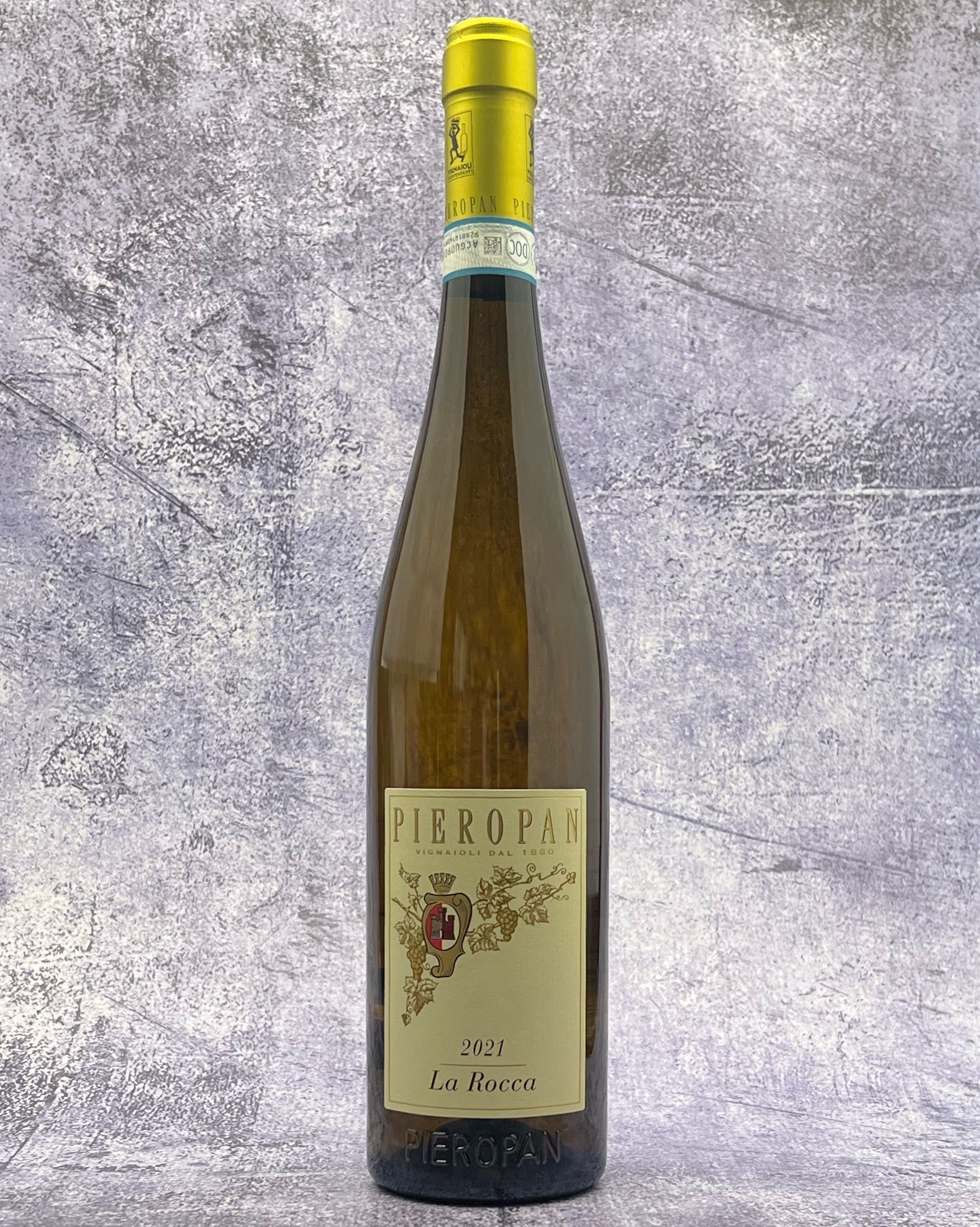From: Soave Classico, Italy
Blend/Grape Varietal: Garganega
Taste & Critical Acclaim: La Rocca is the most ambitious cru of Pieropan, sometimes not preferred to the fresher Calvarino blended with Trebbiano di Soave (aka Turbiana) from volcanic soils. La Rocca is based on 100% Garganega from the chalky soil surrounding the village of Soave. This 2021 vintage is brilliant and intense yellow with golden hints. A characterful wine with notes reminiscent of exotic fruit and nuts on the nose, soft and persistent on the palate, with hints of spice, length, and elegance.
“A different, fuller-weighted brood, boasting ample stone fruits, nutmeg, and truffle. Savvy use of oak (tonneaux and larger format French) and extended lees aging. A vineyard purchased in 1976, situated directly behind the town's castle. Lower altitude, with clay and limestone (rather than the more pervasive volcanic), finding effortless confluence with a winemaking approach that has long-defined this fuller-weighted, late-harvested, highly textural expression. While an outlier stylistically, there is often a fleck of botrytis, all tamarind and dried mango, that melds with the underlying tension to impart generosity and evince authority.” — James Suckling, 95 points
“Rich yet linear, it is a wine of such profound balance that it can weaken the knees. The 2021 opens with rich and golden apples, honeysuckle, roasted hazelnuts and fresh clover honey. As the wine develops, the minerality shines and brings more nuance to the wine. The palate is textured, layered and so well-structured that you might forget that this is wine, not art. Apricots, baked pear and sweet spices drive the palate toward that mineral edge on the finish.” Wine Enthusiast, 95 Points
Pairing: Makes an excellent partner to complex dishes, even with strong flavors particularly risottos such as porcini, or celery, squash and almond, salt cod and other fish including salmon, scallops and crab. We’re sharing a high/low recipe today, for
Soda Battered Baccalà with Sour Cream and Caper Sauce.
About. Pieropan was established in 1880 in the Soave region of Veneto, Italy, by Leonildo Pieropan. Situated in the Soave Classico zone, Pieropan's vineyards thrive in volcanic soil, an ideal terroir for cultivating indigenous grape varieties. The estate primarily focuses on Garganega, the main grape for their signature Soave wines, and Trebbiano di Soave, a secondary grape that adds complexity to their blends.
Pieropan's winemaking philosophy balances tradition and modernity with a strong emphasis on sustainable practices. Their wines embody a distinct sense of place, highlighting the unique terroir of the Soave region. Notable wines include the Soave Classico DOC, particularly the La Rocca and Calvarino single-vineyard expressions, both celebrated for their complexity and elegance.
Pieropan consistently garners high scores from international critics, earning recognition for its balanced, elegant wines with exceptional aging potential. The estate is currently managed by Andrea and Dario Pieropan, who continue their family's rich winemaking heritage while embracing innovation to elevate the Soave appellation to international acclaim.
Plenty of terms on wine labels are used without care, concern, or regulation. In America, one of those terms is “Reserve” … anybody can use it, anytime, anywhere. And for most of the world, they could put ‘classic’ on a label without anybody’s permission. But in Italy, the term “Classico” means something very clear. The term “Classico” on an Italian label refers to a region's old, historic, original center, often with a history that traces back to Roman times. It is in these historic vineyards that usually the best wines of a region are produced.
For instance, the region of Chianti is quite large, encompassing a large swath of land from Pisa and Florence to the north and far south of Sienna. But Chianti Classico is only in the heart of the region, between Florence and Sienna, and it is here that the historic cultural home of Chianti lies.
A dramatic style and topographic difference between Classico and non-Classico regions can be found in Soave, located just outside Verona. The traditional grape variety of this area is Garganega, which has a style of textured, rich, and beautiful (and the best examples show a kick of that is, making it one of the best food wines around). When Garganega is grown in the volcanic soil of the Soave Classico region, it expresses the region’s true terroir. Still, it can sometimes be truly underwhelming when it’s grown in the outlying plains (and bottled simply as ‘Soave’). (There are always exceptions to this rule, however.)
The problem? They both say “Soave” on the label, so unless you know that “Soave Classico” is basically a totally different wine you might be dismissing a category based on drinking some of the mass, industrial-produced wine that is in the market under the ‘Soave’ moniker.
The Garganega grape has several clones, the Garganega Tipica (most common), the Garganega Dario or Grassa (more common in flat areas), the Garganega Verde (most common in the hills near Soave) and finally the Garganega Agostega (earlier and more susceptible to disease, almost totally abandoned today). The Garganega berry is white, medium spheroid, golden yellow with thick and juicy pulp. The bunch is long, cylindrical, with wings, relatively sparse, with a spine that often splits at the tip. The leaf is medium, pentagonal, and five-lobed.

